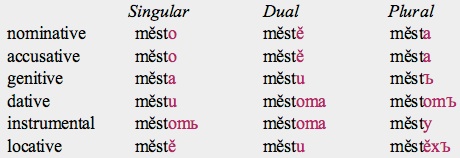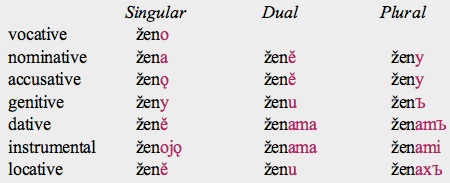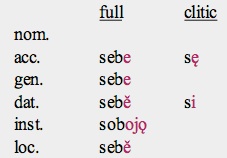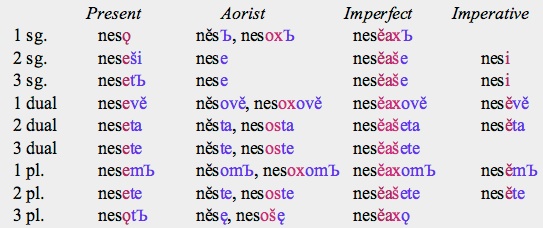An insatiable appetite for ancient and modern tongues


Alternative Name: Old Church Slavic.
Classification: Indo-European, Balto-Slavic, Slavic, South Slavic. Other South Slavic languages are Serbo-Croat, Slovenian, Bulgarian and Macedonian.
Overview. Old Church Slavonic is the first attested Slavic tongue. It was a literary language, based on Slavic dialects of the Balkans, developed by the brother monks Cyril and Methodius, in the 9th century, in order to convey translations of Greek ecclesiastical texts. The earliest translations were written in the Glagolitic alphabet created by the brothers themselves. In the 10th century, it started to be replaced by the Cyrillic script that is still used today to write Russian, Bulgarian, Serbian and other Slavic and non-Slavic languages. Old Church Slavonic is the main source of information about the early history of the South Slavic languages, Bulgarian and Macedonian.
Old Church Slavonic spread soon to other Slavic regions where it became the religious and literary vehicle of Orthodox Slavs throughout the Middle Ages. After the 12th century, it is known as Church Slavonic which has remained as a liturgical language into modern times. It had influenced the modern Slavic tongues, especially literary Russian.
Status: Extinct. Old Church Slavonic is attested from the late 9th to the 11th centuries. After the 11th century, it evolved into Church Slavonic.
Distribution. Initially in Great Moravia (now part of the Czech Republic) and Bulgaria; later in other Slavic areas.
Varieties. Western (Macedonian) and Eastern (Bulgarian). There is a chronological difference between the two. The Macedonian variety, based on the dialect spoken in Thessalonica, was employed in the kingdom of Great Moravia for missionary activity in the late 9th century. When Slavonic was forbidden in Great Moravia in 885, the Bulgarian kingdom became a centre for translations of religious texts that have some linguistic features different from those of the Macedonian form of Old Church Slavonic.
Oldest Documents. They are the translations done between 863-885 by the brothers Cyril and Methodius, along with their disciples, in the kingdom of Great Moravia, like the Psalter (Book of Psalms) and Gospel lectionaries (excerpts from the Gospels to be read at church services).
Phonology
Vowels (11). As Old Church Slavonic pronunciation can only be deduced from a small corpus of written texts, we show the vowels in transliteration but their equivalence in the International Phonetic Alphabet (between brackets) is tentative. ь and ъ are reduced vowels; ъ in western dialects was rounded. The central-back vowels у, ъ, and front vowels other than i did not occur word-initially. Nasalized and oral vowels are contrasted in word-final position.

Consonants (23). Old Church Slavonic, like all Slavic languages, have palatalized consonants. Besides, ń, ŕ , ĺ, which are palatalized versions of n, r, l, the stops p, b, k, g and the fricative x have palatalized allophones. Consonants are never found at the end of a syllable.

Script and Orthography
Old Church Slavonic was written in two alphabets known as Glagolitic and Cyrillic. The earliest texts were translations in Glagolitic, a script devised in the kingdom of Great Moravia by Constantine, known also as St. Cyrill, and his brother Methodius. The Cyrillic script was created in the Balkans after the expulsion of the Moravian mission in 885 by disciples of St. Cyrill. We show below, the early Cyrillic script used to write Old Church Slavonic with its transliteration and, between brackets, the approximate equivalence of each letter in the International Phonetic Alphabet:

Morphology
-
Nominal. Old Church Slavonic has a complex nominal morphology reflecting that of Proto-Indo-European (the hypothetical ancestor of all Indo-European languages). Nouns and adjectives are inflected for three genders, three numbers and six or seven cases.
-
•gender: masculine, feminine, neuter. Nouns ending in -o or -e in the nominative singular are neuter; those in -a are feminine except when referring to a male person, those ending in -ь or -Ъ are masculine.
-
•number: singular, dual, plural. Two coordinated singular subjects take a dual verb. Collective subjects agree with verbs in plural.
-
•case: nominative, vocative, accusative, instrumental, dative, genitive, locative.

-
Human nouns and short masculine adjectives in the singular have a vocative case.
-
In the dual there are only three sets of forms:
-
nominative/accusative
-
genitive/locative
-
dative/instrumental.
-
There are five noun declensions (distinguished by the inflection of the genitive singular). The declension of the masculine noun mǫžu (man) is shown above.
-
Note: The accusative singular is identical either to the nominative singular or to the genitive singular.

-
The declension of the neuter noun město ('place') is as follows:

-
The declension of the feminine noun žena ('woman/wife') is as follows:
-
•adjectives: can be formed from a noun stem plus an adjectival suffix. They distinguish gender and number, and are declined in six cases like nouns and pronouns. Regular comparative adjectives are formed with the suffix -ěj, to which are added the inflectional suffixes.The superlative is usually the same as the comparative, but occasionally has the prefix najь-.
-
•pronouns: personal, reflexive, demonstrative, interrogative, indefinite, negative. Pronouns are declined in all cases except the vocative.
-
Personal pronouns as well as reflexive pronouns have full and enclitic forms. The latter usually stand after the first accented word of a clause.
-
The nominative forms of the first and second person pronouns are only used for emphasis, being otherwise unnecessary because the subject is implicit in the verb. The oblique forms, however, are quite commonly used.
-
The third person pronoun is most commonly used in oblique cases. It is formed from the stem j- (for example, masculine singular accusative jego, genitive jemu, ablative jь, instrumental (jimь, locative jemь). When a nominative form is required a demonstrative pronoun is employed.
-
Forms of the reflexive pronoun are found only in the oblique cases and in the singular (it refers to the subject as a whole). The declension patterns of personal pronouns are shown below.

-
The reflexive pronouns inflect as follows:

-
Possession is marked by the possessive adjective/pronouns mojь (‘my’), tvojь (‘your’), našь (‘our’), vašь (‘your’ plural). For the third person in all numbers, and for first and second persons in the dual, the genitive of the personal pronoun is used.
-
Demonstrative pronouns: sь (‘this’), tъ (‘this/that’), onъ (‘that’).
-
Interrogative pronouns: kъto (‘who?’), čьto (‘what?’). They can also function as indefinite pronouns.
-
Indefinite pronouns: kъto (‘anybody’), čьto (‘anything’), někъto (‘someone’), něčьto (‘something’).
-
-
Negative pronouns: nikъtože (‘nobody’), ničьtože (‘nothing’).
-
Verbal
-
•person and number: 1s, 2s, 3s; 1dual, 2 dual, 3 dual, 1p, 2p, 3p.
-
•tense: present, aorist, imperfect, perfect, pluperfect, periphrastic futures, future perfect.
-
The present, aorist, and imperfect are simple tenses; the others are compound ones. The present may express an habitual or an ongoing action as well as the future, the imperfect expresses an unfinished past action or a former habitual action, while the aorist marks a single event occurred in the past.
-
The perfect relates a preceding action relevant to the present. It is formed with the present tense of the verb byti (‘to be’) as an auxiliary plus the resultative participle or l-participle (see non-finite forms) of the lexical verb.
-
The pluperfect expresses an action which occurred prior to a point of time in the past. It is formed with the imperfective or aorist of byti plus the resultative participle of the lexical verb.
-
The future was usually expressed by the present but there were several periphrastic futures formed with the auxiliary verbs xotěti (‘will’) or xЬtěti (‘wish’); iměti (‘have’) plus an infinitive. There was also a future perfect combining the future of byti with the resultative participle.
-
•mood: indicative, subjunctive, imperative.
-
The subjunctive is formed with the resultative participle plus an auxiliary. It expresses potentiality, conditionality or wishes.
-
The imperative forms for the second person (in all numbers) and for the first person (in the dual and plural) are attested regularly.
-
•aspect: perfective (a completed action), imperfective (an ongoing or habitual action), perfect (refers to a state or to an action began in the past whose effects perdure).
-
•voice: active, passive. The passive voice is expressed with forms of byti (‘to be’) or byvati (‘to become’) + the passive participle (past or present) or with the reflexive pronoun sę.
-
•conjugations: There are two conjugations in the present:
-
1)the ǫ conjugation adds the infix -ǫ- just after the stem in the 3rd person plural (sometimes in the 1st singular too), while for other persons the infix is -e-.
-
2)the ę conjugation adds the infix -ę- in the 3rd person plural and i in the other persons.
-
The aorist has three different formations: asigmatic, sigmatic, and "new aorist". In the asigmatic aorist the personal endings are added directly to the aorist stem (obtained by dropping the -ti ending of the infinitive); in the sigmatic aorist the affix -s(o)- is added between the stem and the personal endings; in the "new aorist" the affix -ox- is added between the stem and the personal endings.
-
The distinctive marker of the imperfect is the affix -ах- or -ěах- added to the aorist stem (-ах- is appended to verbs with a stem ending in -а or -ě, the affix -ěах- to all other verbs).

-
The conjugation of the ǫ class verb nesti ('to carry') is as follows:
-
The aorist forms shown here are the asigmatic followed by the “new aorist” (2nd and 3rd sg. are identical in both).
-
black = stem
-
red = tense affix
-
blue= personal endings.
-
•non-finite forms: infinitive (stem + the suffix ti), supine, and a variety of participles (present active and passive, past active and passive). There are two past active participles: the l-participle or resultative participle is only used to form compound tenses; a second past active participle behaves like an adjective.
Syntax
Word order: Old Church Slavonic had apparently a free word order, all possible orders of subject, object and verb are found, but as the extant texts are translations from Greek they tend to follow the word order of the originals. Subject pronouns can be omitted because person and number are encoded in the verb.
Interrogative sentences: Yes/no questions have the verb or some other emphasized element obligatorily preposed and followed by the particle li, which is not used with interrogative pronouns. In information-seeking questions interrogative pronouns occupy the initial position in a clause, but may be preceded by a personal pronoun.
-
ty kъto esi
-
you who are
-
Who are you?
Subordinate clauses: jegda (‘when, after’), dońьdeže (‘while’), jako (‘because’) are used to introduce them.
Conditional clauses: use the subjunctive (unreal conditions) or the indicative (real conditions).
Negation: Verbal negation is expressed by the particles ne or ni immediately preceding the main verb. When there is only one verb, it is negated with ne; when there is more than one verb, ne negates the more prominent, ni the less prominent; when the verbs are equally prominent only ni is used. In negative clauses the direct object is marked either by the genitive or the accusative.
Lexicon
Old Church Slavonic has few borrowings (color terms, body parts, kinship terms), mainly from Greek and German. Romance languages and Turkic were also (minor) sources of loanwords. There are also a few words borrowed from Iranian.
Basic Vocabulary
one: jedinъ
two: dъva
three: trьje
four: četyre
five: pętь
six: šestь
seven: sedmь
eight: osmь
nine: devętь
ten: desętь
hundred: sъto
father: otьcь
mother: mati
brother: bratrъ
sister: sestra
son: synъ
daughter: dъšti
head: glava
eye: oko
foot: noga
heart: srьdьce
tongue: jęsykь
Literature. Old Church Slavonic texts are translations and not creative works.
-
© 2013 Alejandro Gutman and Beatriz Avanzati
Further Reading
-
-'Old Church Slavonic'. D. Huntley. In The Slavonic Languages, 125-187. B. Comrie & G. G. Corbett (eds). Routledge (1993).
-
-Old Church Slavonic Grammar. H. G. Lunt. De Gruyter Mouton (1974).
-
-Old Church Slavonic Online. T. B. Krause & J. Slocum. Linguistics Research Center. The University of Texas at Austin. Available at: http://www.utexas.edu/cola/centers/lrc/eieol/ocsol-9-X.html
-
-The Dawn of Slavic: an introduction to Slavic philology. A. M. Schenke.Yale University Press (1995).
-
-The Entry of the Slavs into Christendom. A. P. Vlasto. Cambridge University Press (1970).
Old Church Slavonic

Address comments and questions to: gutman37@yahoo.com
MAIN LANGUAGE FAMILIES
LANGUAGE AREAS
Languages of Ethiopia & Eritrea
LANGUAGES by COUNTRY
LANGUAGE MAPS
-
• America
-
• Asia
-
Countries & Regions
-
-
Families
-
• Europe
-
• Oceania